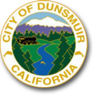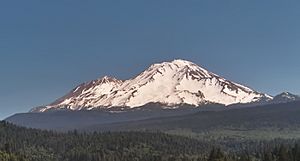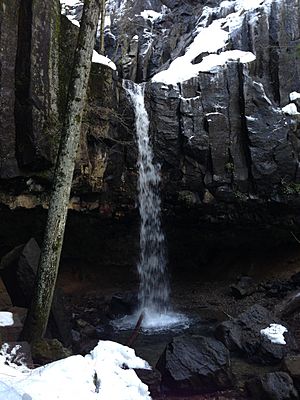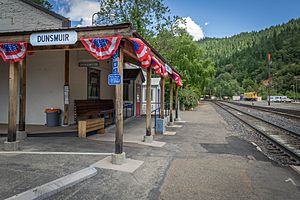Dunsmuir, California facts for kids
Quick facts for kids
Dunsmuir, California
|
||
|---|---|---|
| City of Dunsmuir | ||

The California Theater in Dunsmuir on a sunny day
|
||
|
||
| Motto(s):
"Home of the best water on Earth"
|
||
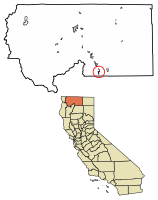
Location of Dunsmuir in Siskiyou County, California
|
||
| Country | ||
| State | ||
| County | Siskiyou | |
| Incorporated | August 7, 1909 | |
| Area | ||
| • Total | 1.64 sq mi (4.25 km2) | |
| • Land | 1.60 sq mi (4.16 km2) | |
| • Water | 0.04 sq mi (0.09 km2) 2.14% | |
| Elevation | 2,290 ft (698 m) | |
| Population
(2020)
|
||
| • Total | 1,707 | |
| • Density | 1,064.21/sq mi (410.79/km2) | |
| Time zone | UTC-8 (Pacific (PST)) | |
| • Summer (DST) | UTC-7 (PDT) | |
| ZIP Code |
96025
|
|
| Area code(s) | 530 | |
| FIPS code | 06-20242 | |
| GNIS feature IDs | 277501, 2410372 | |
Dunsmuir is a small city in Siskiyou County, located in northern California. It sits along the upper Sacramento River. In 2020, about 1,707 people lived there, which was a small increase from 1,650 people in 2010.
Today, Dunsmuir is a popular place for tourists in Northern California. Many visitors come to enjoy outdoor activities like fishing, skiing, climbing, or just seeing the beautiful sights. In the past, when steam locomotives were common, Dunsmuir was an important railroad center. Extra steam engines were added here to help trains climb the steep hills to the north.
Contents
Exploring Dunsmuir: Fun for Visitors
Dunsmuir is in the Shasta Cascade area of Northern California. It's a great spot for tourists who love nature and history.
Outdoor Adventures in Dunsmuir
- Fishing: The Sacramento and McCloud Rivers are famous for trout fishing. The city even stocks the river with large rainbow trout during summer. You can fish all year round, even catching big trout right in the city!
- Hiking and Climbing: You can explore amazing places like Mount Shasta, Castle Crags, or the Trinity Alps. There are also beautiful waterfalls like Mossbrae Falls and Hedge Creek Falls, and lakes such as Lake Siskiyou and Castle Lake.
- Winter Sports: In winter, people come for both alpine skiing (downhill) and cross-country skiing.
- Biking: The area offers many trails for cycling.
Discovering Dunsmuir's History and Culture
Dunsmuir has kept its old-fashioned look from the 1920s and 1930s. This makes it a cool place for people interested in history and culture.
- Railroad History: Because of its long connection to the railroad, many railfans (people who love trains) visit Dunsmuir. They enjoy watching and hearing the trains in the deep Sacramento River canyon. Dunsmuir is even an official "Train Town" with Union Pacific Railroad.
- Historic Buildings: The downtown area is a special historic district. The old California Theater is being fixed up, and it even has its original Wurlitzer organ back!
Local Festivals and Events
During the summer, Dunsmuir hosts fun weekend festivals:
- "State of Jefferson Brewfest"
- "Dogwood Daze"
- "Railroad Days"
- "Tribute to the Trees" – an outdoor dinner and concert by the river in the city park.
The city also has two parks by the river: Dunsmuir City Park and Botanical Gardens and Tauhindauli Park. These parks offer great spots for fishing and picnics.
Dunsmuir's Past: A Journey Through Time
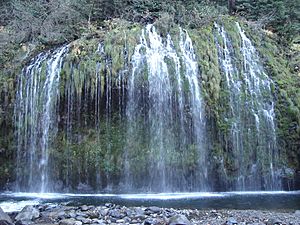
People have lived in and around Dunsmuir for over 5,000 years. The Okwanuchu tribe of Native Americans lived here when the first European-Americans arrived in the 1820s.
Early Explorers and Settlers
- In the 1820s, hunters and trappers traveled through Dunsmuir's location on the Siskiyou Trail.
- By the mid-1830s, pioneers moved cattle through the Sacramento Canyon.
- In 1841, a famous U.S. exploration group passed through the area.
- The California Gold Rush in the 1850s brought more people. The first non-Native American settlers built a toll bridge and a hotel at Upper Soda Springs.
The Railroad Era and Naming the Town
- In 1887, the Central Pacific Railroad was completed. This led to the creation of modern Dunsmuir.
- The railroad built a special area where steam engines were fixed and added to trains to help them climb steep hills. This area needed a town, first called 'Poverty Flats' or 'Pusher'.
- In 1888, a man named Alexander Dunsmuir visited. He loved the area so much that he offered to donate a fountain if the town would be named after him. The town agreed, and Dunsmuir's fountain is still there today! It's near the baseball field where famous players like Babe Ruth once played.
- By the early 1900s, Dunsmuir was the biggest town in Siskiyou County.
- When trains switched from steam to diesel in the mid-1950s, fewer railroad workers were needed, and the town became smaller.
A Historic Town Today
Today, Dunsmuir still looks a lot like it did in the 1920s and 1930s. It's even listed on the National Register of Historic Places. The downtown area is a special historic district.
The Cantara Loop Incident
On July 14, 1991, a train derailed near Dunsmuir, spilling a chemical into the upper Sacramento River. This caused a lot of damage to the river's plants and animals. Many fish, amphibians, and insects died.
However, the Upper Sacramento River has mostly recovered thanks to efforts by groups like The Upper Sacramento River Exchange. The river is now healthy again, and people can enjoy fishing there all year. Big trout are often caught right in the city!
City Parks and Beautiful Gardens
Dunsmuir has several parks for everyone to enjoy.
Dunsmuir City Park and Botanical Gardens
- This is a 10-acre park with a beautiful botanical garden.
- Volunteers help maintain the gardens.
- In 1924, famous baseball players Babe Ruth and Bob Meusel from the New York Yankees even played an exhibition game here!
Tauhindauli Park and Trail
- This park is on the site of the old Upper Soda Springs resort along the Sacramento River.
- It has about 10 acres of flat land by the river and trails that go north to Dunsmuir City Park.
- The park was improved to make it better for recreation and to help control floods.
- New pathways, fishing spots, and picnic areas were added.
- The river's natural habitat was restored, which helps local wildlife.
Historic Resorts and Waterfalls
Dunsmuir is home to several historic spots and stunning waterfalls.
Shasta Springs
Shasta Springs was a popular summer resort in the late 1800s and early 1900s. It was located just north of Dunsmuir, along the Siskiyou Trail.
Upper Soda Springs
Upper Soda Springs is right on the banks of the Sacramento River in Dunsmuir. This historic site has about 10 acres of flat ground and natural mineral water springs. The State of California and the City of Dunsmuir are working to create a new park here.
Mossbrae Falls
Mossbrae Falls is a beautiful waterfall that flows into the Upper Sacramento River. It's located just south of Shasta Springs. Currently, the hiking trail to the falls along the Union Pacific Railroad tracks is closed for safety reasons.
Hedge Creek Falls
Hedge Creek Falls is another amazing waterfall in Dunsmuir. What makes it special is a small cave behind the waterfall, so visitors can walk right behind the falling water! There's also a viewing platform with a great view of Mount Shasta. The trail to the falls is short and easy to access from Interstate 5, making it a popular stop for travelers.
Dunsmuir's Weather: Climate Overview
Dunsmuir has a climate with cool, wet winters and hot, dry summers. It gets a lot more rain than nearby cities like Yreka and Medford.
- Summer: There are about 59 days each year when temperatures reach 90°F (32°C) or higher.
- Winter: About 104 mornings each year have temperatures of 32°F (0°C) or lower. Extreme cold is rare.
- Record Temperatures: The hottest temperature ever recorded was 109°F (43°C). The coldest was 4°F (-16°C).
- Rainfall: Dunsmuir gets about 63 inches (161 cm) of rain each year. More than half of this rain falls in December, January, and February.
- Snowfall: On average, Dunsmuir gets about 27 inches (68 cm) of snow each year, usually on about 13 days.
| Climate data for DUNSMUIR TRTMT PL, CA (1991-2020 normals, extremes 1978-) | |||||||||||||
|---|---|---|---|---|---|---|---|---|---|---|---|---|---|
| Month | Jan | Feb | Mar | Apr | May | Jun | Jul | Aug | Sep | Oct | Nov | Dec | Year |
| Record high °F (°C) | 70 (21) |
78 (26) |
83 (28) |
92 (33) |
99 (37) |
105 (41) |
109 (43) |
109 (43) |
106 (41) |
99 (37) |
81 (27) |
75 (24) |
109 (43) |
| Mean daily maximum °F (°C) | 48.6 (9.2) |
52.4 (11.3) |
57.2 (14.0) |
63.3 (17.4) |
72.8 (22.7) |
81.2 (27.3) |
89.9 (32.2) |
89.1 (31.7) |
83.5 (28.6) |
70.9 (21.6) |
56.3 (13.5) |
47.7 (8.7) |
67.8 (19.9) |
| Mean daily minimum °F (°C) | 29.9 (−1.2) |
30.8 (−0.7) |
33.4 (0.8) |
37.1 (2.8) |
44.1 (6.7) |
50.2 (10.1) |
54.0 (12.2) |
51.5 (10.8) |
46.2 (7.9) |
39.3 (4.1) |
33.6 (0.9) |
30.1 (−1.1) |
40.0 (4.4) |
| Record low °F (°C) | 12 (−11) |
8 (−13) |
18 (−8) |
22 (−6) |
26 (−3) |
33 (1) |
39 (4) |
41 (5) |
31 (−1) |
25 (−4) |
18 (−8) |
4 (−16) |
4 (−16) |
| Average precipitation inches (mm) | 11.08 (281) |
10.46 (266) |
9.20 (234) |
4.90 (124) |
2.83 (72) |
1.33 (34) |
0.15 (3.8) |
0.20 (5.1) |
0.68 (17) |
3.04 (77) |
6.89 (175) |
12.57 (319) |
63.33 (1,609) |
| Average snowfall inches (cm) | 8.2 (21) |
6.7 (17) |
4.7 (12) |
0.6 (1.5) |
0.0 (0.0) |
0.0 (0.0) |
0.0 (0.0) |
0.0 (0.0) |
0.0 (0.0) |
0.0 (0.0) |
1.9 (4.8) |
7.8 (20) |
29.9 (76.3) |
| Average precipitation days (≥ 0.01 in) | 14.7 | 12.8 | 13.2 | 11.4 | 7.7 | 4.0 | 1.3 | 1.3 | 2.3 | 5.6 | 10.3 | 13.8 | 98.4 |
| Average snowy days (≥ 0.1 in) | 3.2 | 2.5 | 1.3 | 0.5 | 0.0 | 0.0 | 0.0 | 0.0 | 0.0 | 0.0 | 1.0 | 3.4 | 11.9 |
| Source: NOAA | |||||||||||||
Dunsmuir's Location and Unique Features
Dunsmuir is located at 41°13′18″N 122°16′23″W / 41.22167°N 122.27306°W.
Geography and Water
- The city covers about 1.7 square miles (4.4 km2), mostly land with a small amount of water.
- Dunsmuir is about 2,350 feet (716 meters) above sea level.
- The Sacramento River flows through the city, creating exciting whitewater rapids in the summer.
- The city's drinking water is naturally filtered by Mount Shasta's lava layers. This means it doesn't need extra treatment, which is why Dunsmuir's slogan is "Home Of The Best Water On Earth."
- You can find three water fountains in the Historic District on Dunsmuir Avenue.
Getting Around Dunsmuir: Transportation
Train Travel
- The Coast Starlight train, run by Amtrak, stops daily at the Dunsmuir Amtrak station.
- This is the only Amtrak stop in Siskiyou County and the northernmost one in California.
- The station is cared for by local residents and train fans. It has a museum, restrooms, and a place to wait for the train.
- Dunsmuir is like a railroad museum itself, with an old working turntable.
Roads and Air Travel
- Interstate 5 runs through Dunsmuir, connecting it to other cities like Yreka and Redding.
- The Dunsmuir Municipal-Mott Airport is a small airport owned by the city, located just north of the downtown area.
Famous People from Dunsmuir
Some notable people were born or live in Dunsmuir:
- Ray Coleman: A professional baseball player.
- Nick Eddy: A professional football player.
- Ernie Wasson: A well-known gardener and author.
- Robert Williams: A famous astronomer and former president of the International Astronomical Union.
See also
 In Spanish: Dunsmuir para niños
In Spanish: Dunsmuir para niños


